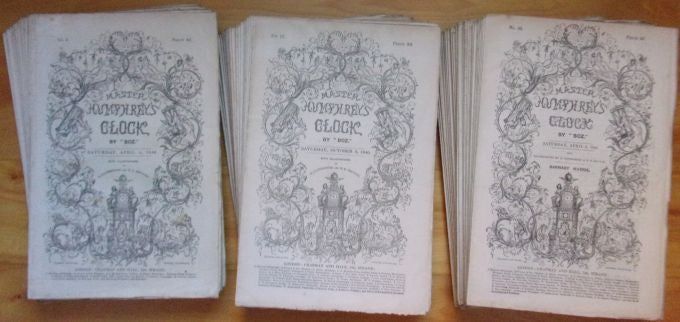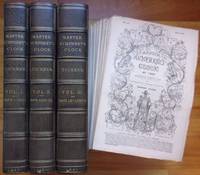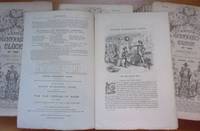MASTER HUMPHREY'S CLOCK [The Old Curiosity Shop + Barnaby Rudge, in 88 weekly parts]
- SIGNED
- 1840
1840. Phiz. [in 88 weekly parts] By "Boz." With Illustrations by G[eorge]. Cattermole and H[ablot]. K. Browne. London: Chapman and Hall, 1840-1841. 88 weekly serial parts in original pictorial cream self-wrappers.
First Edition of THE OLD CURIOSITY SHOP and of BARNABY RUDGE, in 88 weekly parts -- the first of the four forms in which these two novels were originally issued. After the publication of NICHOLAS NICKLEBY in monthly parts in 1839, Dickens decided to create a weekly serial named MASTER HUMPHREY'S CLOCK, within which he would issue his future novels. The first issue, beginning THE OLD CURIOSITY SHOP, was issued on April 4, 1840. When, with the death of Little Nell, that novel was completed 44 issues later, Dickens started right in with BARNABY RUDGE (the 45th part is a transition part). When that novel was completed in the 88th issue (November 27, 1841), Dickens terminated the MASTER HUMPHREY'S CLOCK experiment (in a Preface to several of the final parts he had told his readers why) and, beginning with MARTIN CHUZZLEWIT after his trip to America, reverted to his standard monthly serialization. These weekly parts are quite different from Dickens's monthly ones: each weekly part consisted of one large sheet folded to create sixteen pages (twelve of text, plus a front and rear "wrapper"), without any of the myriad inserted advertisements common to the monthly parts. In addition, the illustrations are woodcuts within the text, rather than separate steel-engraved plates. After every fourth or fifth weekly part, they were also available bound together into twenty monthly parts, trimmed down a bit and with added advertisements and colored wrappers -- making them similar to Dickens's other novels. Also, MASTER HUMPHREY'S CLOCK was available in (three) clothbound volumes, each published at an interval of about seven months; Parts 26, 52 and 88 contain the preliminary leaves for those three volumes. Finally, simultaneous with the publication of Vol III, MASTER HUMPHREY'S CLOCK was divided and issued as two separate one-volume novels titled THE OLD CURIOSITY SHOP and BARNABY RUDGE (though still with MHC pagination). This set is complete and is in close-to-fine condition. A few parts (such as the first two and the last) have minor cover soil or edge-wear -- but the other 85 are generally FINE (Parts 16 & 46 are even unopened, i.e., still in the form of one large folded sheet). Gimbel A49; Hatton & Cleaver pp 161-182 (monthly parts); Smith I pp 44-57; Wolff 1804 (three volumes); Eckel (published in 1913) pp 67-70: "Of the four issues the weekly one is difficult to obtain in clean condition and is therefore the costliest". Housed in three handsome full-morocco cases with inner chemises.
First Edition of THE OLD CURIOSITY SHOP and of BARNABY RUDGE, in 88 weekly parts -- the first of the four forms in which these two novels were originally issued. After the publication of NICHOLAS NICKLEBY in monthly parts in 1839, Dickens decided to create a weekly serial named MASTER HUMPHREY'S CLOCK, within which he would issue his future novels. The first issue, beginning THE OLD CURIOSITY SHOP, was issued on April 4, 1840. When, with the death of Little Nell, that novel was completed 44 issues later, Dickens started right in with BARNABY RUDGE (the 45th part is a transition part). When that novel was completed in the 88th issue (November 27, 1841), Dickens terminated the MASTER HUMPHREY'S CLOCK experiment (in a Preface to several of the final parts he had told his readers why) and, beginning with MARTIN CHUZZLEWIT after his trip to America, reverted to his standard monthly serialization. These weekly parts are quite different from Dickens's monthly ones: each weekly part consisted of one large sheet folded to create sixteen pages (twelve of text, plus a front and rear "wrapper"), without any of the myriad inserted advertisements common to the monthly parts. In addition, the illustrations are woodcuts within the text, rather than separate steel-engraved plates. After every fourth or fifth weekly part, they were also available bound together into twenty monthly parts, trimmed down a bit and with added advertisements and colored wrappers -- making them similar to Dickens's other novels. Also, MASTER HUMPHREY'S CLOCK was available in (three) clothbound volumes, each published at an interval of about seven months; Parts 26, 52 and 88 contain the preliminary leaves for those three volumes. Finally, simultaneous with the publication of Vol III, MASTER HUMPHREY'S CLOCK was divided and issued as two separate one-volume novels titled THE OLD CURIOSITY SHOP and BARNABY RUDGE (though still with MHC pagination). This set is complete and is in close-to-fine condition. A few parts (such as the first two and the last) have minor cover soil or edge-wear -- but the other 85 are generally FINE (Parts 16 & 46 are even unopened, i.e., still in the form of one large folded sheet). Gimbel A49; Hatton & Cleaver pp 161-182 (monthly parts); Smith I pp 44-57; Wolff 1804 (three volumes); Eckel (published in 1913) pp 67-70: "Of the four issues the weekly one is difficult to obtain in clean condition and is therefore the costliest". Housed in three handsome full-morocco cases with inner chemises.




